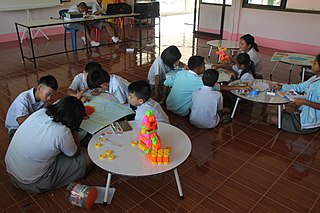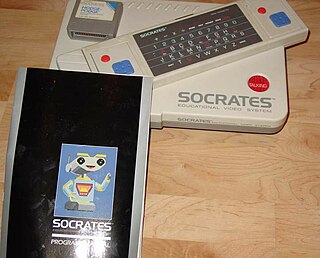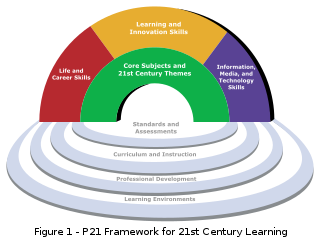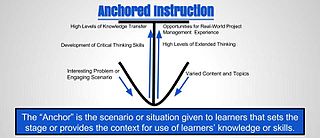Related Research Articles
A teaching method comprises the principles and methods used by teachers to enable student learning. These strategies are determined partly on subject matter to be taught and partly by the nature of the learner. For a particular teaching method to be appropriate and efficient it has to be in relation with the characteristic of the learner and the type of learning it is supposed to bring about. Suggestions are there to design and selection of teaching methods must take into account not only the nature of the subject matter but also how students learn. In today's school the trend is that it encourages much creativity. It is a known fact that human advancement comes through reasoning. This reasoning and original thought enhances creativity.
Instructional scaffolding is the support given to a student by an instructor throughout the learning process. This support is specifically tailored to each student; this instructional approach allows students to experience student-centered learning, which tends to facilitate more efficient learning than teacher-centered learning. This learning process promotes a deeper level of learning than many other common teaching strategies.
Critical thinking is the analysis of facts to form a judgment. The subject is complex, and several different definitions exist, which generally include the rational, skeptical, unbiased analysis, or evaluation of factual evidence. Critical thinking is self-directed, self-disciplined, self-monitored, and self-corrective thinking. It presupposes assent to rigorous standards of excellence and mindful command of their use. It entails effective communication and problem-solving abilities as well as a commitment to overcome native egocentrism and sociocentrism.
Educational games are games explicitly designed with educational purposes, or which have incidental or secondary educational value. All types of games may be used in an educational environment, however educational games are games that are designed to help people learn about certain subjects, expand concepts, reinforce development, understand a historical event or culture, or assist them in learning a skill as they play. Game types include board, card, and video games.

Problem-based learning (PBL) is a student-centered pedagogy in which students learn about a subject through the experience of solving an open-ended problem found in trigger material. The PBL process does not focus on problem solving with a defined solution, but it allows for the development of other desirable skills and attributes. This includes knowledge acquisition, enhanced group collaboration and communication. The PBL process was developed for medical education and has since been broadened in applications for other programs of learning. The process allows for learners to develop skills used for their future practice. It enhances critical appraisal, literature retrieval and encourages ongoing learning within a team environment.
Collaborative learning is a situation in which two or more people learn or attempt to learn something together. Unlike individual learning, people engaged in collaborative learning capitalize on one another's resources and skills. More specifically, collaborative learning is based on the model that knowledge can be created within a population where members actively interact by sharing experiences and take on asymmetric roles. Put differently, collaborative learning refers to methodologies and environments in which learners engage in a common task where each individual depends on and is accountable to each other. These include both face-to-face conversations and computer discussions. Methods for examining collaborative learning processes include conversation analysis and statistical discourse analysis.

Project-based learning (PBL) is a student-centered pedagogy that involves a dynamic classroom approach in which it is believed that students acquire a deeper knowledge through active exploration of real-world challenges and problems. Students learn about a subject by working for an extended period of time to investigate and respond to a complex question, challenge, or problem. It is a style of active learning and inquiry-based learning. PBL contrasts with paper-based, rote memorization, or teacher-led instruction that presents established facts or portrays a smooth path to knowledge by instead posing questions, problems or scenarios.
This is an index of education articles.
Reflective practice is the ability to reflect on one's actions so as to engage in a process of continuous learning. According to one definition it involves "paying critical attention to the practical values and theories which inform everyday actions, by examining practice reflectively and reflexively. This leads to developmental insight". A key rationale for reflective practice is that experience alone does not necessarily lead to learning; deliberate reflection on experience is essential.
An intelligent tutoring system (ITS) is a computer system that aims to provide immediate and customized instruction or feedback to learners, usually without requiring intervention from a human teacher. ITSs have the common goal of enabling learning in a meaningful and effective manner by using a variety of computing technologies. There are many examples of ITSs being used in both formal education and professional settings in which they have demonstrated their capabilities and limitations. There is a close relationship between intelligent tutoring, cognitive learning theories and design; and there is ongoing research to improve the effectiveness of ITS. An ITS typically aims to replicate the demonstrated benefits of one-to-one, personalized tutoring, in contexts where students would otherwise have access to one-to-many instruction from a single teacher, or no teacher at all. ITSs are often designed with the goal of providing access to high quality education to each and every student.
This glossary of education-related terms is based on how they commonly are used in Wikipedia articles. This article contains terms starting with P – R. Select a letter from the table of contents to find terms on other articles.

An educational video game is a video game that provides learning or training value to the player. Edutainment describes an intentional merger of video games and educational software into a single product. In the narrower sense used here, the term describes educational software which is primarily about entertainment, but tends to educate as well and sells itself partly under the educational umbrella. Normally software of this kind is not structured towards school curricula and does not involve educational advisors.
E-learning theory describes the cognitive science principles of effective multimedia learning using electronic educational technology.
In education, computational thinking (CT) is a set of problem-solving methods that involve expressing problems and their solutions in ways that a computer could also execute.
Interactive Learning is a pedagogical approach that incorporates social networking and urban computing into course design and delivery. Interactive Learning has evolved out of the hyper-growth in the use of digital technology and virtual communication, particularly by students. Beginning around 2000, students entering institutes of higher education have expected that interactive learning will be an integral part of their education. The use of interactive technology in learning for these students is as natural as using a pencil and paper were to past generations.
Games and learning is a field of education research that studies what is learned by playing video games, and how the design principles, data and communities of video game play can be used to develop new learning environments. Video games create new social and cultural worlds – worlds that help people learn by integrating thinking, social interaction, and technology, all in service of doing things they care about. Computers and other technologies have already changed the way students learn. Integrating games into education has the potential to create new and more powerful ways to learn in schools, communities and workplaces. Games and learning researchers study how the social and collaborative aspects of video game play can create new kinds of learning communities. Researchers also study how the data generated by game play can be used to design the next generation of learning assessments.

21st century skills comprise skills, abilities, and learning dispositions that have been identified as being required for success in 21st century society and workplaces by educators, business leaders, academics, and governmental agencies. This is part of a growing international movement focusing on the skills required for students to master in preparation for success in a rapidly changing, digital society. Many of these skills are also associated with deeper learning, which is based on mastering skills such as analytic reasoning, complex problem solving, and teamwork. These skills differ from traditional academic skills in that they are not primarily content knowledge-based.

Anchored Instruction is a technology centered learning approach, which falls under the social constructionism paradigm. It is a form of situated learning that emphasizes problem-solving within an integrated learning context, which can be examined from multiple perspectives. "In other words, the learning is contextualized to provide students with realistic roles that serve to enhance the learning process",. During teaching, activities are designed or tied around an "anchor", such as an adventure or story, with a problem at the end, that needs to be resolved. The connection made between the content and the authentic context is referred to as "anchoring". These models typically embed all the information needed for the problem to be solved, such data and hints. Anchored instruction is akin to problem-based learning (P.B.L.) with the exception of its open-endedness.
Creative education is when students are able to use imagination and critical thinking to create new and meaningful forms of ideas where they can take risks, be independent and flexible. Instead of being taught to reiterate what was learned, students learn to develop their ability to find various solutions to a problem. Coming up with various out-of-the box solutions is known as divergent thinking and there is no one way of cultivating this skill - largely due to the newness of the concept and the limited scientific information on creativity.
Crystal Island: Uncharted Discovery is an educational video game created by a team of educators and computer scientists at the Center for Educational Informatics aimed at teaching students upper elementary science education, focusing on landforms, navigation, and modeling. In the game, students play as shipwrecked adventurers on a volcanic island. To escape the island, they must complete a series of quests that test their critical thinking skills and teach them content-related information. Upon completion of the quests, the players gain access to a new area of the island which contains a multi-skill quest that requires students to use the knowledge and skills they learned during the previous quests. Once the final quest is completed, the players gain access to a communication device which allows them to call the outside world for rescue. The game was made with the Unity game engine. It was made by the same creators of the game Crystal Island: Lost Investigation.
References
- Tettegah, S. (2005). Technology, Narratives, Vignettes, and the Intercultural and Cross-Cultural Teaching Portal. Urban education, 40(4), 368–393.
- Bailey, B.P., Tettegah, S.Y. Bradley, T.J. (2006, in press). Clover: Connecting Technology and Character Education Using Personally-Constructed Animated Vignettes. Interacting with Computers.
- Campbell, P.B. (1996) How Would I Handle That? Using Vignettes to Promote Good Math and Science Education. American Association for the Advancement of Science.
- Chau, J., A. Chang, I. Lee, W. Ip, D. Lee and Y. Wootton. (2001) Effects of Using Videotaped Vignettes on Enhancing Students' Critical Thinking Ability in a Baccelaureate Nursing Programme. J. Advanced Nursing, 36(1), 112–119.